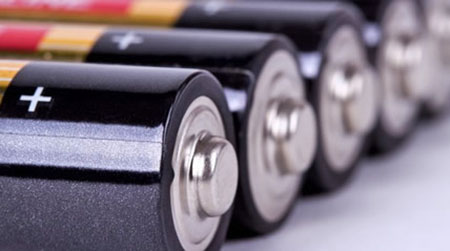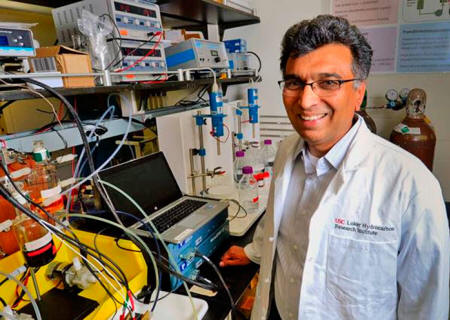|
from
USC-UniversitySouthernCalifornia
Website
Scientists Develop Cheap, Rechargeable Organic Batteries Built from Eco-Friendly Components
that Last 15 Years...
Scientists at USC have developed a water-based organic battery that is long lasting and built from cheap, eco-friendly components.
The new battery, which uses no metals or toxic materials, will make energy more resilient and efficient by creating a large-scale means to store energy for use as needed.
Lithium-ion batteries have made portable, rechargeable electronics commonplace.
Unfortunately, they do have some glaring
drawbacks, including heat issues, being made with rare,
toxic elements, and the fact the technology doesn't scale up
very well, which limits applications.
Sri Narayan collaborated with G.K. Surya Prakash, professor of chemistry and director of the USC Loker Hydrocarbon Research Institute, as well as USC's Bo Yang, Lena Hoober-Burkhardt and Fang Wang.
Their experiments demonstrated that the organic redox flow cells could be charged and discharged multiple times at high efficiency without any sign of degradation.
The analysis of cell performance showed that the mass transport of reactants and products and their solubilities were critical to achieving high current densities.
Renewable energy resources
The batteries could pave the way for renewable energy sources to make up a greater share of the nation's energy generation.
Solar panels can only generate power when the sun's shining, and wind turbines can only generate power when the wind blows. That inherent unreliability makes it difficult for power companies to rely on them to meet customer demand.
With batteries to store surplus energy, which can be doled out as needed, that sporadic unreliability could cease to be an issue.
The new battery is based on a redox flow design - similar in design to a fuel cell, with two tanks of electroactive materials dissolved in water.
The solutions are pumped into a cell containing a membrane between the two fluids with electrodes on either side releasing energy. The design has the advantage of decoupling power from energy.
The tanks of electroactive materials can be made as large as needed - increasing the total amount of energy the system can store - or the central cell can be tweaked to release that energy faster or slower, altering the amount of power (energy released over time) that the system can generate. The team's breakthrough centered on the electroactive materials.
USC professor Sri Narayan's research focuses on the fundamental and applied aspects of electrochemical energy conversion and storage to reduce the carbon footprint of energy use and by providing energy alternatives to fossil fuel Wednesday, June 10, 2014 in Los Angeles. (USC Photo / Gus Ruelas)
While previous battery designs have used metals or toxic chemicals, Narayan and Prakash wanted to find an organic compound that could be dissolved in water.
Such a system would create a minimal impact on the environment and would likely be cheap, they figured. Through a combination of molecule design and trial-and-error, the scientists found that certain naturally occurring quinones - oxidized organic compounds - fit the bill.
Quinones are found in plants, fungi, bacteria and some animals, and are involved in photosynthesis and cellular respiration.
Currently, the quinones needed for the batteries are manufactured from naturally occurring hydrocarbons. In the future, the potential exists to derive them from carbon dioxide, Narayan said.
The team has filed several patents in regards to design of the battery and next plans to build a larger scale version.
This research was funded by the ARPA-E Open-FOA program (DE-AR0000337), the University of Southern California, and the Loker Hydrocarbon Research Institute.
|


